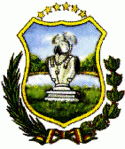Tarija
 |
 |
The name of Tarija is said to come from Francisco de Tarija or Tarifa. However, researched information disproves that probability. Members of the first group of Spaniards to enter the valley where present-day Tarija is situated, stated that the name of Tarija was already in use. This group did not include anyone by the name of Francisco de Tarija. Similar-sounding toponyms exist for surrounding places, such as Tariquia and Taxara. In 1826 the citizens of Tarija voted to become part of Bolivia. In 1807, Tarija had become separated from Upper Peru to become part of the jurisdiction of Salta (part of Argentina), but because of its close ties to what became Bolivia, it returned to its original jurisdiction. In 1899, Argentina renounced its claims in exchange for the Puna de Atacama.
The valley that Tarija is situated in was first occupied by Western Hemispheric indigenous groups, such as the Churumatas. Subsequently, the Inca Empire – administered by the Quechua civilization – conquered the land and dispersed the Churumatas and other local groups over wide territories of the Andes. Mitimaes is the Quechuan name that the Incas used for the resisting ethnic groups they uprooted and then dispersed geographically. The Tomatas are thought to have been brought to San Juan del Oro River in the vicinities of Tarija from Norte Chico, Chile. The Tomatas appear to have given placenames from their old lands to their new area of settlement thus explaining the existence of "Chilean" placenames such as Loa, Calama, and Erqui (Elqui) in Bolivia. In 1574 conquistador Luis de Fuentes resettled the Tomatas next to the city Tarija.
When the Spanish first arrived to the valley of Tarija they encountered several stone roads, most likely the remnants of pre-Incaic cultures, such as that of the Churumatas. However, during that period, the presence of indigenous peoples remained sparse within the valley. Several of the pre-Incaic roads and trails have been preserved, and currently function as a walking trail for Tarijeños.
Map - Tarija
Map
Country - Bolivia
 |
 |
| Flag of Bolivia | |
The sovereign state of Bolivia is a constitutionally unitary state, divided into nine departments. Its geography varies from the peaks of the Andes in the West, to the Eastern Lowlands, situated within the Amazon basin. One-third of the country is within the Andean mountain range. With 1098581 km2 of area, Bolivia is the fifth largest country in South America, after Brazil, Argentina, Peru, and Colombia (and alongside Paraguay, one of the only two landlocked countries in the Americas), the 27th largest in the world, the largest landlocked country in the Southern Hemisphere, and the world's seventh largest landlocked country, after Kazakhstan, Mongolia, Chad, Niger, Mali, and Ethiopia.
Currency / Language
| ISO | Currency | Symbol | Significant figures |
|---|---|---|---|
| BOB | Boliviano | Bs | 2 |
| ISO | Language |
|---|---|
| AY | Aymara language |
| QU | Quechua language |
| ES | Spanish language |















